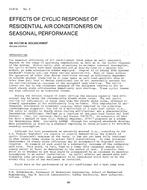
CI-81-06-2 — Effects of Cyclic Response of Residential Air Conditioners on Seasonal Performance
The seasonal efficiency of air conditioners (heat pumps as well) generally depends on the range of operating temperatures as well as on the cyclic response of the system. Historically, when attempting to estimate seasonal consumption, the cyclic effects have been neglected and an hour-by-hour or a weather bin method, or some alternative scheme employed. Chapter 43 of ASHRAE 1980 Systems Handbook clearly outlines these various alternatives. Most of these account for operation at other than design conditions through an efficiency dependent on outside weather (referred to in some cases as part-load operation when at other than full load or design conditions) but do not necessarily account for the non-instantaneous response of the equipment upon start-up. The cyclic losses are due to the transient response of the equipment causing it not to reach steady state efficiencies immediately upon start-up. These cyclic losses are also referred to as transient losses.
Although the test procedures as currently enacted are capable of clearly demonstrating the effects of cyclic (transient) response on the tests, it has not yet been fully confirmed to what extent these relate to actual field installations. In some instances improvement of steady state efficiency may be accompanied by degraded cyclic response. An example of such would be a substantial increase of the condensing coil size. This could, in turn, lead to a lower SEER (seasonal energy efficiency ratio) at least as determined by the method of test. A question does arise as to whether or not this would be accompanied by an increase in seasonal consumption in an actual installation. As cyclic effects get masked with sufficiently long on-times, one parameter to be considered would have to be the actual duty cycle of the equipment as installed.
Field data on the performance of an air conditioner and a heat pump have been taken, analyzed, and reported in the literature (Murphy et al (1979), Goldschmidt et al (1980) and Hart et al (1980). From these data the relationship of cyclic response to seasonal performance can be estimated.
Results of an ARI sponsored study on the test method for predicting SEER have been made public through a report by both ARI and DOE (Thomas et al (1980). This study tabulated the results (available at that time) from industry testing on a total of 166 units.
Product Details
- Published:
- 1981
- Number of Pages:
- 14
- File Size:
- 1 file , 1.1 MB
- Product Code(s):
- D-CI-81-06-2
- Note:
- This product is unavailable in Russia, Belarus


